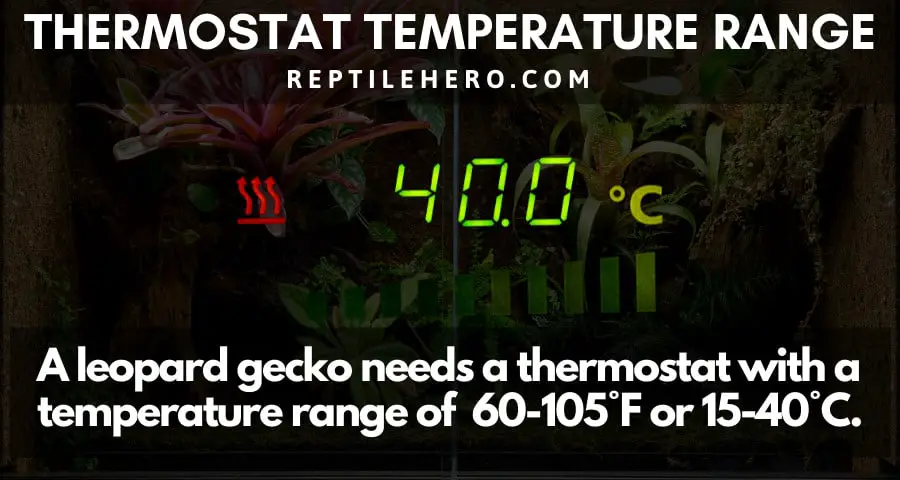Choose the Right Thermostat for Your Gecko Tank [7 Factors]
In the past, reptile keepers would simply plug in their heat mats directly into a wall socket or power strip, turn it on, then forget about it. However, as this practice became widespread, so did the cases of thermal burns in geckos and snakes.
If you don’t want your pet to become part of such statistics, get the right thermostat for their set-up!
In general, a reptile keeper and/or breeder must consider 7 factors when selecting the appropriate thermostat for any leopard gecko tank set-up:
- Type of thermostat
- Temperature range
- Sensor probe
- Set-up compatibility
- Maximum wattage load
- Safety features
- Practical bonus features
What thermostat will let you save more money in the long run: a 10-dollar mat-stat that is “plug-and-play” or a 100-buck professional thermostat that is highly programmable? In most cases, the answer is the latter—why? Continue reading to learn more!
If you are in a hurry then you can jump to our best pick: 1) The Herpstat and the 2) the inkbird. Do not forget to also read our full review thermostat review.
Why Do You Need a Good Thermostat in Leopard Gecko Tanks?

A thermostat is an electronic device that provides reptile keepers and breeders the means of controlling and monitoring the environment of an animal’s tank when electrical heaters are used.
Ectothermic animals, leopard geckos included, are highly reliant on external sources of warmth (e.g., sunlight) in maintaining their preferred body temperature as they produce insufficient body heat by themselves.
In captivity, infrared radiation (heat) is provided through the use of various electrical devices such as:
- Halogen heat lamps
- Deep heat projectors (DHPs)
- Ceramic heat emitters (CHEs)
- Under-tank heat mats
- Radiant heat panels (RHPs)
However, much like any other device that needs electricity to operate, electrical heaters can malfunction and, in turn, cause serious harm when used in the humble homes of our scaly friends without any precautionary measure.
Hence, the use of a thermostat is crucial because it serves as an effective preventive measure against both hyperthermia and overheating in geckos, well known to be especially temperature-sensitive animals.
Fortunately, gone are the days when thermostats are considered as “luxury” items for us regular reptile pet parents.
Now, members of the reptile-keeping community have come to realize that being able to control and maintain proper temperatures is just as important as providing the appropriate heat source, if not more.
7 Factors to Check in a Thermostat for Your Leopard Gecko Tank
Some people think that any type of thermostat will suffice to keep their pet’s vivarium up and going. But this isn’t a hundred percent accurate. There are many points people have to take into account depending on their leo’s specific tank design and set-up.
#1 – Type of Thermostat
Sure, more and more leopard gecko owners are including thermostats in their shopping list. But the problem is that not everyone is aware of the fact that there are 3 main types of thermostats used within the reptile-keeping community. Despite being able to provide power to heaters, they operate quite differently.
Reptile thermostats can be classified into 3 main categories:
- On/Off or mat-type
- Pulse-proportional
- Dimming-proportional
On/Off or Mat-Type Thermostats
Years ago, when people mention the word thermostat most reptile pet parents would only think of the on/off type because these were easy to find and buy. I would even argue that the great majority of regular keepers didn’t know that there were other types of thermostats available.
So what exactly is an on/off thermostat and how does it work?
A mat-type thermostat, also known as a non-proportional, on/off, or mat-stat, controls the heat output of an electrical infrared radiator plugged into it by cyclically restoring and cutting off the power supply to the device.
To maintain the set temperature point or range within the tank, the on/off stat turns off the heater(s) once the temperature reading of the sensor probe in the gecko tank goes above the setpoint and on when it drops below—a constant switch from on to off, again and again.
Because of this, mat-stats are considered the most basic type of thermostat. Generally, such thermostats are also the easiest to operate as there is not much programming that needs to be set and done.
Unfortunately, numerous downsides come with the use of regular mat-stats—the erratic flashing of light, premature bulb burnout, as well as significant fluctuations in tank temperatures, among many things.
As such, on/off stats are only recommended for non-light-emitting heaters like:
- Mats or pads
- Wires or cables
- Tapes
Despite all the drawbacks, I would confidently say that it is much better to have an affordable on/off stat to act as a fail-safe for your lovely leopard gecko than to have nothing at all.
Pulse Thermostats
If you are looking for a better but highly similar substitute for the humble mat-stat for your leopard gecko’s non-light-emitting heaters, then you should go for a pulse-proportional unit.
A pulse-proportional thermostat regulates heaters by either decreasing or increasing the intensity and frequency of electrical pulses sent to the infrared radiator to reach and maintain optimal tank temperatures.
Simply put, this type of thermostat will send strong and quick pulses of energy when the temperature is below the target threshold. Then once the set target temperature is obtained, the pulses of energy are weakened and slowed down so that the output of the heating element remains stable.
Furthermore, long-time keepers and breeders have observed that non-light-emitting or “dark” heaters (e.g., ceramic emitters, heat panels) last longer when used with pulse stats than on/off stats.
Pulse thermostats are also capable of keeping more stable tank temperatures than on/off stats.
Dimming Thermostats
Another popular type of proportional thermostat is the dimming thermostat—considered by most experienced keepers as the best type since it is compatible with virtually all heating equipment.
In contrast to on/off and pulse thermostats, a dimming thermostat supplies a steady stream of electric currents to whichever heating element is connected to it. With this, modulation of heat output is done by simply raising or lowering the degree to which the power is supplied.
When used in combination with a light-emitting heater—say, a halogen or incandescent lamp—this process becomes rather noticeable as the light either gets dimmed down or brightened up.
Just like pulse stats, dimming stats operate in an inversely proportional manner to the pre-set level of temperature, the upper and lower limit of which will be decided by you, the user. Power delivered increases as the temperature drops. Conversely, the power decreases as the temperature rises.
It is also worth mentioning that dimming stats have been discovered to prolong the average rated life or life span of most, if not all, infrared radiators used for leopard gecko
Multi-Functional Thermostats
Now, let’s move on to briefly discuss multi-functional thermostats, which are also referred to as professional thermostats.
Multi-functional stats are not a distinct classification of thermostats. Instead, these are single thermostat units that are capable of functioning as on/off, pulse, and/or dimming types.
Multi-functional thermostats are generally more readily available in North America than it is in the United Kingdom and the rest of Europe. Plus, they commonly fetch a much higher price than single-function proportional thermostats like this one on Amazon.
I prefer multi-functional stats since I get more bang for my buck, especially since newer models also offer options for cooling and humidity control. I can also adjust its settings based on a bunch of other factors—all of which will be discussed in greater detail in succeeding sections.
Even though they usually come with manuals, they have a more complex interface and require more time and effort to properly set up but it’s worth it. In any case, there are also tutorials available online.
#2 – Temperature Range
On average, the total controllable temperature range of a thermostat for a leopard gecko tank may range anywhere between a minimum of 25°F (-4°C) to a maximum of 140°F (60°C).
Certain brands manufacture specific model lines based on the temperature range. Some “high-range” thermostats can only handle up to 90°F (32°C). Other “specialty” stats can gauge temperatures as high as 220°F (104°C), but these are hard to find.
Remember: Leopard geckos need a good thermal gradient within their tank to allow for proper thermoregulation. However, you don’t necessarily need a thermostat with an extensive temperature range for your leo’s vivarium.

Then again, if you have any plans of setting up your small-scale private zoo, the opposite would be true. Wider temperature ranges will let you accommodate not only leopard geckos, but a variation of other species as well.
What is the ideal ambient temperature gradient for a leopard gecko tank?
The ideal ambient temperatures for a leopard gecko tank must be within 70-80°F (21-27°C) on the cool side and approximately 85-90°F (29-32°C) on the warm side of the gecko tank.
The surface temperature of the basking spot on the warm side should not go over 95-100°F (35-38°C) or your gecko may burn to a crisp.
Moreover, nighttime temperature drops must never fall way below 65 °F (18°C) for a long time or your leo will most likely freeze to death.
#3 – Sensor Probe
Here we have the third factors that truly decide which thermostat to go for.
First off—you may be wondering: what does a temperature probe do exactly?
Overall, the sensor probes of reptile thermostats are devices designed to measure temperature [1]. Subsequently, this information is relayed back into the unit’s processor and the thermostat adjusts the power being supplied into the heater accordingly.
What they are: Thermostat probes are electronic components in a protective casing of plastic, resin, ceramic, glass, and/or metal composite found at the end of one cord—among at least two—connected to the thermostat unit. Normally, they are typically black or silver.
Cord length: Probes also vary in terms of cord length: from 5 to 12 feet (approx. 1.5 to 3.7 meters). So if your tank is considerably far from the nearest wall outlet, make sure that the probes are long enough to reach well into your leopard gecko’s vivarium without any strain.
Light and/or humidity: Interestingly, there are also probes which either gauge light or humidity alone. Others work to detect both heat and light—in theory, this sounds promising. But if the design plan is not executed properly, reptile owners are bound to experience problems during the thermostat’s operation.
Water-resistance: Though most probes are water-resistant to some extent, not all of them are completely safe for prolonged submersion. If you plan to have one in the body of your gecko tank’s water feature (e.g. shallow pond), look for aquarium-safe or submersible sensor probes.
Ease of placement: At times, these probes may have a lock or a suction cup attached to the cord for easier placement. You can also adhere the probe to the basking tile or on one side of the enclosure with foil tape or silicone.
Probe replaceability: Some thermostats have sensor probes that are permanently and directly wired into the main unit, and tampering with such components may void your warranty. On the flip side, other thermostats have detachable probes which could be replaced should there be any issue with it or if you need a specific type of sensor probe (e.g. humidity).
Sensor Probe Troubles: Unnatural Day-Night Cycling
One of the most common issues with thermostat units is the flawed operation of their temperature sensor probes with light-sensitive tips. The resulting automatic day-night cycling—which is determined by light alone—negatively affects a gecko’s sleep-wake pattern.
Many reptile keepers have had issues using certain dimming stats with day-night cycling which causes heat lamps to behave erratically, disturbing their gecko’s biological clock.
Frequently, the problem lies in the fact that the daytime and nighttime modes were not programmable by users. Instead, the switch between day and night settings are automatically determined by the light-sensitive temperature probes of such units—daytime when there is light, nighttime when there is none.
I have heard of and read numerous bad experiences such as daytime settings kicking in in the middle of the night because of low light or nighttime mode being turned on due to placement of the probe in the shade.
#4 – Set-Up Compatibility
Now, I want you to picture the perfect vivarium for your precious leopard gecko. Even better, create a sketch, map out how you want to arrange everything—equipment for not only heating, but also cooling, lighting, and humidity.
When selecting a thermostat for leopard gecko tank(s), one must consider the following:
- The number of channels
- The number and types of heaters
- The number of tanks
- The number of probes.
The number of channels: The most basic thermostats will have at least one channel or port. So in the event that you only have a single halogen heat lamp for daytime heating, you’re all set with a single channel thermostat.
Reptile keepers living up north need a dual-channel or multi-channel thermostat. They are recommended because regional temps get much lower than 65 °F (18°C) all year round there—a single primary heating element will not be able to provide sufficient infrared radiation.
For me, multi-channel thermostats are the best because they allow for experimentation and improvements in a single tank’s heating set-up and/or the addition of more exotic pets.
Just make sure to double-check all channels. Some “multi-function” thermostats, in reality, only have one operating mode although there are multiple outlets on the unit. Other professional units only allow predetermined operations in specific ports (e.g., heating in the first, lighting in the second, etc.).
The number and types of heaters: Most basic set-ups generally need a single primary heating element: halogen (daytime) or deep heat projector (nighttime or all-day). Both emit visible light—then again DHPs only produce little to no light. Here a simple one-channel dimming thermostat will be more than enough unless there are multiple tanks.
In comparison, more advanced set-ups typically use at least two infrared radiators both light-emitting and dark heaters.
To reiterate, infrared radiators that also emit visible light will lead to periodic or sporadic flickering when connected to on/off stats while dimming stats boost or lessen the brightness. Pulse stats cause both.
The number of tanks: If you have a single leopard gecko tank to monitor and have no plans of buying, adopting, or rescuing another reptile any time soon, you can get away with one thermostat.
However, if you have dreams of building up a huge collection of reptiles—or any other animal which will need an enclosure of its own—the better option would be to invest in a high-end multi-channel thermostat that can accommodate multiple different tanks.
By doing so, you won’t have to worry about mountains of wires and cables getting tangled up which frequently happens when using a lot of single-channel stats for multiple tanks.
The number of probes: More often than not, affordable dual and multi-channel thermostats only come with a lone probe for the processing of temperature readings within one tank.
So even though you can plug numerous heaters from a bunch of different vivariums to a multi-channel stat with a single probe, you cannot accurately control and monitor all of them in real-time. That probe can only regulate the heater of the tank it is placed in.
Ideally, each heating device should be hooked up to one port and have a dedicated probe to monitor its heat output.
#5 – Maximum Wattage Load
Generally, thermostats are capable of handling a total power ranging from 100 to 1800 Watts. With multi-channel units, this is equally divided among the channels (e.g., 450 Watts per channel of a 900-Watt dual-channel dimming thermostat) with a minimum of 40 Watts.
Needless to say, the overall power rating of equipment you are planning to hook up to a thermostat must never exceed its maximum wattage load unless you are looking for pain—both physical and financial.
So let’s say, for example, that you have a 120-gallon wooden vivarium for your little leo with an 80-Watt carbon heat projector and a 90-Watt halogen heat lamp.
How do you determine the necessary minimum wattage load appropriate for this heating setup? Well, it’s pretty simple. Just find the total power rating of all heating devices.
What are the average power ratings of common heat sources for leopard gecko tanks?
| Heating Device for Leopard Gecko | Average Range of Power Rating (Watts) |
| Heat mat or under-tank-heater | 10-50 |
| Ceramic heat emitter (CHE) | 25-250 |
| Deep heat projector (DHP) | 50-100 |
| Halogen heat lamp | 30-100 |
Going back to the earlier case—add 80 and 90 Watts, then you get 170 Watts.
Ergo, you need a thermostat with a wattage load or capacity of 170 Watts, at the very least. Then for a dual or multi-channel stat, each outlet should have a load of 80. Any less than that, there will be high chances of overloading.
#6 – Safety Features (5 Important Design Aspects)
It is advisable to always choose thermostats with a multitude of safety features to ensure your gecko’s health and well-being, if available. This includes:
1 – Grounded plugs. If you aren’t familiar, grounded plugs are those with 3 prongs: two parallel poles and a central grounding pole above.
The grounding pole redirects extra power away from the main unit of thermostats and prevents power surges as well as electric shock.
2 – Password protection. For people who are parents to both human and reptile babies, this is a much-needed safety feature. With it, you won’t have to worry about your kids playing with and messing up the settings you have calibrated on your thermostat.
3 – Automatic shut-off. Look for thermostats with resettable fuses and/or safety relays so that none of your heaters fail on due to both internal and external malfunctions. Both components are designed to cut off power supplied to devices connected to the thermostat outlets without damaging them.
By fail on, I mean that heaters continue operating on full blast once the thermostat acts up—this is a common occurrence with on/off stats. Fortunately, newer mat-stat models also have auto shut-off features.
4 – Sound alarm system. Due to power outages, bizarre weather events, accidentally disconnected equipment, faulty sensor probes, and the like, alarm systems are indispensable.
This is tripped on immediately after the temperature readings in your tank go a degree over or under your programmed temperature thresholds. As a result, you will be notified of potential issues and you can resolve them as soon as possible.
5 – Real-time notification. Not all leopard gecko owners have the privilege of working from home. So even if your thermostat does come with a sound alarm system while you are away for work, you won’t realize that something is wrong no matter how loud it blares.
If this rings true for you, look for a thermostat that will send you warning notifications via a mobile application, text message, and/or e-mail in real-time.
#7 – Practical Bonus Features (7 Programmable Functions)
The last factor you should look into when choosing a thermostat for your leo’s vivarium is whether or not there are extra features available.
Below are common programmable features available in professional and high-end thermostats which are not necessary but are highly helpful nonetheless.
1 – Digital information display. Decades ago, most thermostats used within the reptile community were simple analog models which did not display any vital information on a screen.
There were only values printed around the dial to show at what level it has been set to. Unfortunately, this either fades or gets completely erased over time.
They either simply had a dial and one or two indicator lights. So you didn’t have a way of knowing whether or not they were working properly in your gecko’s tank unless you monitor them closely with a thermometer.
More modern professional reptile stats nowadays have backlit digital information displays. It provides data on:
- Current time and/or date
- Set temperature range
- Actual temperature reading
- Night drop schedule
- Amount of power supplied (per heater)
- Selected mode(s) of operation
There are even thermostats with touchscreen displays which may double as the user interface.
2 – Day-night cycling. When looking for a nighttime drop or day-night cycling function in a thermostat, you should carefully look into the thermostat model and read through the user manual if readily available.
Like I explained earlier, some thermostats are advertised specifically for the temperature cycling feature however some are not programmable—with special probes relying only on the presence of light.
What you want is a day-night temperature differential which you can personally set on a regular schedule.
A good schedule would be something similar to 90°F or 32°C from 6 AM until 6 PM, then 72°F or 22°C from 6 PM of the same day to 6 AM of the next day.
3 – Built-in timer. Besides the temperature night drop function which can be manually set by the gecko keeper or breeder, recently released models also provide built-in timers for all operational modes.
This integrated timer is especially useful for lighting equipment such as UV-B tubes for efficient synthesis of vitamin D3 in leopard geckos [2] and full-spectrum LED lights for optimal plant growth.
You won’t have to buy and set separate plug-in timers for such devices. One multi-function thermostat with multiple channels will suffice.
4 – Temperature ramping. Newbie leopard gecko owners often make the mistake of thinking that heaters that take a while to warm up and reach target temperatures are bad products and that thermostats which have similar effects on such elements are equally poor in quality.
However, the exact opposite is true.
The gradual ramping up and down of an infrared radiator’s heat output—as regulated by a thermostat—mimics the natural increase of temperature during sunrise and decrease during sunset experienced by wild leopard geckos.
Otherwise called a soft start-up or warm-up option, the duration of this function can be set by the user too.
5 – Record-keeping. One of the features I check in newer thermostat models is the capability to not only monitor temperature readings but also keep a log of them over a long time.
Some even collate this data into a cumulative chart for temperature readings in your gecko’s tank.
This helps both beginner and experienced reptile-keepers take note of detailed tank temperatures. With time and practice, even a regular owner will be able to forecast the annual temperature fluctuations their pets experience throughout the different seasons.
6 – Setting retention. Admittedly, not all thermostats are easy to fully install and set up. Others take a lot of time, effort, as well as several calls and e-mails to customer support before nailing the perfect calibration.
So knowing that such settings will be retained in the face of auto shut-offs, failures, and glitches save us from going through the unnecessary stress that comes with having to reprogram it every single time.
7 – Connectivity. More and more manufacturers have also introduced brand new thermostat models that allow for connectivity—which is highly needed by leo owners unable to look after their babies around the clock.
Typically this means that the thermostat can be connected to the internet via WiFi. In effect, data can be uploaded and stored into a mobile application or online server in real-time.
So even if you have to leave your gecko behind for a vacation, you can still keep a close eye on your gecko’s tank environment.
Further Questions
Are rheostats and thermostats the same thing? No, they are not the same thing. Rheostats like this one on Amazon are more similar to the average dimmer switch which is calibrated with a simple dial. Though it may seem almost identical to old-fashioned analog thermostats, the main difference is that rheostats do not have sensor probes.
Are there cheaper dimming or multi-function thermostats online, especially on platforms that allow used items to be put on sale (e.g., eBay)? Definitely—but as always, I strongly recommend against buying dirt-cheap alternatives for important gecko tank equipment such as thermostats as the risks almost always outweigh the potential benefits.
What is a safe but affordable alternative to getting a high-end dimming or multi-function thermostat for light-emitting heaters? If you are still saving up for a dimming or professional thermostat, you can temporarily use a simple lamp dimmer switch and an on/off thermostat to safely regulate your heat lamps. This will require regular temperature checks with both a thermostat and a temperature gun.
Can I run multiple heaters on a single one-channel thermostat? Hypothetically speaking, yes, you can run multiple heaters on a thermostat with only one port provided that all tanks are identically set up for the same species of animal (e.g., leopard geckos.). However, the lack of probes to allot for each enclosure brings more harm than good. In short, this is generally not advisable.
Is it okay to hook up multiple heaters into a power strip before plugging that into a thermostat? The potential harm of this practice is debatable. Some people have done this for decades without any issue whatsoever. Others have experienced tragic consequences such as the death of all animals in their collection.
Takeaways
Reptile thermostats can be classified into 3 primary categories: on/off, pulse, and dimming. In addition, certain models referred to as multi-function thermostats are single electronic devices that can offer two or all three modes.
The temperature range of thermostats for leopard gecko tanks should at least be 60-105°F or approximately 15-40°C.
Replaceable, long, water-resistant temperature sensor probes are better for use with common heating elements found in leopard gecko tanks.
On the whole, a thermostat’s set-up compatibility in terms of total channels, heaters, tanks, and probes must be taken into account.
A leopard gecko’s overall heating set-up must not have a cumulative power rating that goes beyond the thermostat’s maximum wattage load.
A thermostat must have at least one of the following 5 safety features to ensure a leopard gecko’s wellbeing: grounded plugs, password protection, automatic shut-off, Sound alarm system, and real-time notification.
Though not necessary, these 7 programmable features are extremely useful: digital information display, day-night cycling, built-in timer, temperature ramping, record-keeping, setting retention, and connectivity.
Sources
[1] https://www.mouser.com/pdfDocs/Amphenol_AS_NTC_Thermistors.pdf
[2] https://www.sciencedirect.com/science/article/pii/S1096495920301007

![How Do Geckos Walk on Walls? [With Science]](https://www.reptilehero.com/wp-content/uploads/2021/10/G44_-_Redesign-768x614.jpg)

![How to Choose a Halogen Lamp for Your Leopard Gecko [In-Depth]](https://www.reptilehero.com/wp-content/uploads/2021/07/word-image.jpg)
![Leopard Gecko Morphs 101 [Rarity, Price, and Color]](https://www.reptilehero.com/wp-content/uploads/2021/03/word-image-34-768x576.png)

